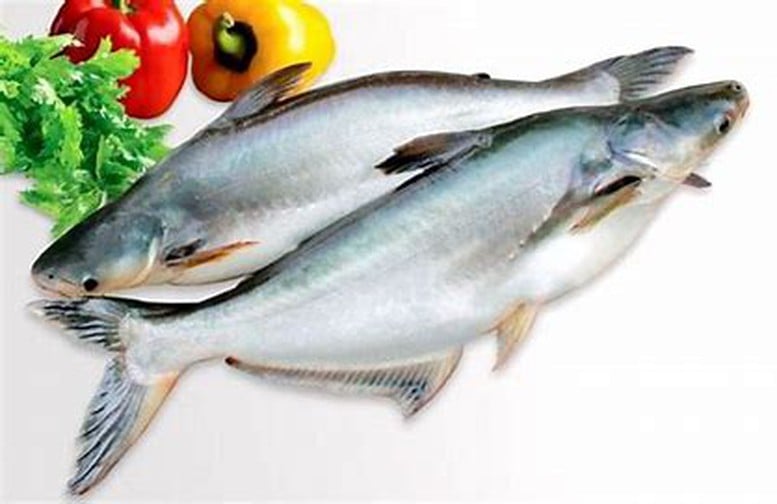
The average export price of pangasius products reached 2.28 USD/kg.
On April 28, the Vietnam Association of Seafood Exporters and Producers (VASEP) announced data from Vietnam Customs showing that pangasius exports in March 2025 reached 182 million USD, up 21% compared to the previous month and 16% compared to the same period in 2024. This growth was strongly driven by consumption demand from two key markets, China (including Hong Kong) and the US, affirming the important role of Vietnamese pangasius in the international market.
In March 2025, the export volume of pangasius to all markets reached nearly 79,000 tons, up 23% over the same period last year, from more than 55,000 tons. The average export price of pangasius products also increased by 2%, reaching 2.28 USD/kg. This recovery took place in most major markets: China and Hong Kong increased by 61%, the US increased by 28%, the EU increased by 73%, ASEAN increased by 11%, Brazil increased by 44%, Mexico increased by 15% and the UK increased by an impressive 120%.
The key factor is strong demand, especially in China in late March, when raw material prices tended to decrease, along with no longer being affected by the long Lunar New Year holiday like in the first two months of the year.
China continues to be the largest consumer market, importing more than 21,000 tons of pangasius in March 2025, recovering strongly after a record low in February. Export value to this market reached 38 million USD, up 6% over the same period in 2024, although the average export price decreased by 4.2%, to 2.04 USD/kg after 6 consecutive months of increase. By the end of the first quarter of 2025, China and the US remained the two leading destinations, with the main product being frozen pangasius fillets.
In the US, the export price of pangasius is currently at $3.40/kg. However, the risk of applying a 46% reciprocal tariff is putting great pressure on exporting businesses. If the tax is applied, the price of pangasius could increase to about $5.10/kg, making it difficult for this product to compete with other white fish such as tilapia or cod. This could lead to a situation of "the more you export, the more you lose", forcing businesses to consider reducing the proportion of exports to the US and shifting to other markets. However, the US's 90-day delay in applying the 46% tariff has given exporters valuable time to transport goods and find alternatives.
However, consumption demand in the US remains a major driver. According to information from VASEP, in the first 11 months of 2024, value-added pangasius exports to the US reached more than 12 million USD, up 2,182% over the same period in 2023, marking a 10-year high. The US lifting anti-dumping duties on Vietnamese fish fillets, under a bilateral agreement signed on January 17, 2025, also opens up strong recovery prospects. If this policy is effectively implemented, the US is likely to regain its position as the largest pangasius import market from China in 2025.
Expected to reach 2 billion USD
Forecasts from VASEP and seafood industry experts show that Vietnam’s pangasius exports will continue to grow in 2025, with an expectation of reaching around US$2 billion, equivalent to the level of 2024. The global economic recovery after the pandemic, along with increasing demand for low-cost protein sources such as pangasius, are favorable factors. In particular, free trade agreements such as the Comprehensive and Progressive Agreement for Trans-Pacific Partnership (CPTPP) and the ASEAN Free Trade Agreement (ATIGA) are helping Vietnamese pangasius penetrate deeper into markets such as Thailand, Mexico and Brazil.
In particular, China continues to be a bright spot for Vietnamese pangasius exports. Although export prices have decreased slightly, demand in this market has increased sharply, especially in the fourth quarter of 2024, when exports reached 163 million USD, up 17% over the same period in 2023. Total pangasius export turnover to China in 2024 reached 581 million USD, up 1% over the previous year. Frozen pangasius fillet products are popular with Chinese consumers, accounting for 60% of total export turnover to this market.
Demand in China is expected to continue to grow through 2025, thanks to the government ’s policies to stimulate consumption and support the real estate market. However, the Vietnamese pangasius industry also faces the challenge of competition from other whitefish species, such as Russian pollock, and a shift in product structure towards lower value-added items, such as whole pangasius.
However, the pangasius industry also faces many challenges. In the US, uncertainty surrounding tariff policies may reduce demand for raw materials in April 2025, as large companies adjust their export strategies. In addition, high input costs, rising fuel and feed prices, and competition from other white fish species require Vietnamese businesses to improve product quality and diversify markets. VASEP recommends that businesses adjust output to suit demand, while taking advantage of incentives from trade agreements to increase competitiveness.
To maintain growth momentum, Vietnam needs to continue to promote negotiations to upgrade the ASEAN-China Free Trade Agreement (ACFTA) to version 3.0, in order to expand trade opportunities with China. At the same time, reaching a tariff agreement with the US will be an important turning point, helping Vietnamese pangasius consolidate its position in this market. In addition, businesses need to focus on value-added products, such as processed pangasius, to meet the increasing demand from international consumers.
Do Huong
Source: https://baochinhphu.vn/trien-vong-cho-xuat-khau-ca-tra-102250429083324974.htm


![[Photo] Ho Chi Minh City holds funeral for former President Tran Duc Luong](https://vphoto.vietnam.vn/thumb/1200x675/vietnam/resource/IMAGE/2025/5/24/9c1858ebd3d04170b6cef2e6bcb2019e)
![[Photo] The Government Standing Committee works with ministries and branches on the real estate market situation.](https://vphoto.vietnam.vn/thumb/1200x675/vietnam/resource/IMAGE/2025/5/24/e9b5bc2313d14c9499b8c9b83226adba)






















![[Photo] Party and State leaders visit former President Tran Duc Luong](https://vphoto.vietnam.vn/thumb/1200x675/vietnam/resource/IMAGE/2025/5/24/960db9b19102400e8df68d5a6caadcf6)


































































Comment (0)